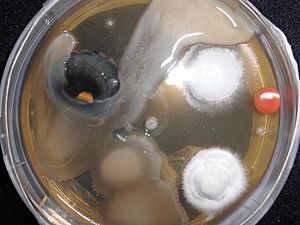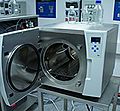Sterilization (microbiology) facts for kids
Sterilization is a super important process that gets rid of or kills all forms of tiny living things, like fungi, bacteria, and viruses. It also removes other harmful things called prions. These tiny organisms are often called microorganisms.
Sterilization makes sure that a surface, object, or liquid – like food or special growing liquids for germs – is completely clean and safe.
You can sterilize things in different ways. Some common methods include using heat, special chemicals, irradiation (like strong light), high pressure, or filtering things out.
It's good to know that sterilization is different from other cleaning methods like disinfection, sanitization, or pasteurization. Those methods only reduce the number of germs, but sterilization aims to get rid of all of them.
When something has been sterilized, we say it is sterile or aseptic.
Contents
Why Sterilization Matters
Sterilization is used in many important areas to keep us safe and healthy.
Keeping Food Safe
One of the first ways people used sterilization was by thoroughly cooking food and boiling water. This helped to kill germs and make food safer to eat.
Later, people learned about canning food using heat. This was a big step in keeping food fresh for a long time. Even today, eating contaminated food or water is a major cause of sickness, especially for children in some parts of the world.
Food sterilization is often part of the canning process. It works with or instead of other ways to keep food fresh, like adding preservatives or putting food in the fridge.
Sterilization in Hospitals and Medicine
Long ago, in Ancient Rome, people knew that heating medical tools could help. But this idea was mostly forgotten during the Middle Ages. Because of this, many people got sick or even died after surgery.
Today, sterilization is super important in medicine. For example, medicines that are injected into your body and liquids given through an IV (intravenous) must be perfectly sterile. This stops any unwanted germs from getting into your body and causing infections.
Images for kids
-
Joseph Lister was a pioneer of antiseptic surgery.
See also
 In Spanish: Esterilización (microbiología) para niños
In Spanish: Esterilización (microbiología) para niños








